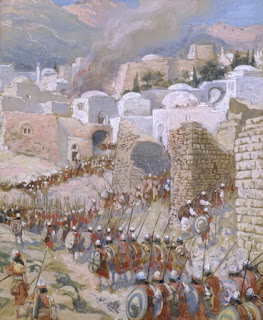Archaeology and the Fall of Jericho
So many events of ancient history are only known through word-of-mouth stories, some artefacts, and even written accounts. The Bible has never been refuted by archaeology, and archaeologists used to respect the Bible even if they were unbelievers. Today, some try to wave off biblical events using bad reasoning.
The Battle of Jericho was a significant event marking the conquest of Canaan. The Israelites were led by Joshua, successor of Moses. Jericho was an imposing city with a double wall, and God miraculously intervened.
 |
| The Taking of Jericho, James Tissot, ca. 1900 |
There are many archaeological facts that correspond to the biblical account, but secular history takes a different track at some point. This helps naysayers concoct excuses to minimize or disregard the significance of the fall of Jericho. When properly examine, however, secularists who wave it off are full of stuff and nonsense.
Determining when Jericho was overthrown by Joshua’s army is significant because it not only supports the date of the Exodus, but it also dates the conquest of Canaan. This date must also synchronize with the destruction of Ai and Hazor, two Canaanite cities destroyed at about the same time. Biblical archaeologists have disagreed over which Jericho wall fell for Joshua, and which was the later wall built by Hiel in the time of Ahab. In this paper it will be shown that Joshua’s wall was the one destroyed at the end of the Early Bronze IIIB period and Hiel’s wall dates to the Middle Bronze I. In addition, the great Middle Bronze II–III embankment fortification that is widely and erroneously considered to be Joshua’s wall was built sometime after Hiel’s wall. . . .
The rest of this very interesting paper is located at "The Walls of Jericho: Dating Joshua’s Conquest of Canaan."
